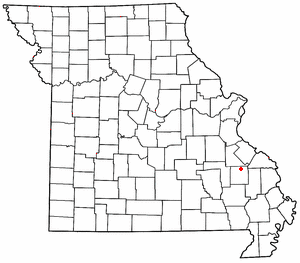Related Research Articles

Sainte Genevieve County, often abbreviated Ste. Genevieve County, is a county located in the eastern portion of the U.S. state of Missouri. As of the 2020 census, the population was 18,479. The largest city and county seat is Ste. Genevieve. The county was officially organized on October 1, 1812, and is named after the Spanish district once located in the region, after Saint Genevieve, patroness of Paris, France.

Longtown is a village in Union Township in Perry County, Missouri, United States. The population was 90 at the 2020 census.

Mine La Motte is an unincorporated community and census-designated place in Madison County, Missouri, United States. It is located approximately six miles north of Fredericktown.

Jackson Township is a subdivision of Ste. Genevieve County, Missouri, in the United States of America, and is one of the five townships located in Ste. Genevieve County.
Henry Platte was an American minister who served as the first native Catholic priest in what is now the State of Missouri in the United States. He was curé of the Church of Ste. Genevieve in Ste. Genevieve, Missouri in 1815, and pastor from 1816 until his death from yellow fever in 1822.

Fenwick Settlement is an abandoned village in Perry County, Missouri, United States. The community was named after the Fenwick family, who were early settlers on the left bank of the Mississippi River in the Spanish Illinois Country.

Union is one of the eight townships located in Perry County, Missouri, in the United States of America.

The Bois Brule Bottom is an alluvial floodplain in Bois Brule Township in Perry County, Missouri stretching between Bois Brule Creek to the west and the Mississippi River to the east.

New Bourbon is an abandoned village located in Ste. Genevieve Township in Ste. Genevieve County, Missouri, United States. New Bourbon is located approximately two and one-half miles south of Ste. Genevieve.
St. Michel is an abandoned village located in Madison County, Missouri, United States. St. Michel is now incorporated into Fredericktown.

Central Township is one of the eight townships located in Perry County, Missouri, United States.

Saline Township is one of the eight townships located in Perry County, Missouri, in the United States of America.

Le Grand Champ is an alluvial floodplain, also called a bottom, extending along the Mississippi River in Ste. Genevieve County, Missouri.

Cinque Hommes Creek is a tributary of the Mississippi River flowing through Perry County, Missouri.

Saline Creek is a creek that rises in western Ste. Genevieve County and flows east briefly passing through a portion of northern Perry County before emptying into an offshoot of the Mississippi River north of St. Mary across from Kaskaskia Island.

Beauvais Township is a subdivision of Ste. Genevieve County, Missouri, in the United States of America, and is one of the five townships located in Ste. Genevieve County.

River aux Vases is a creek that rises in Union Township in western Ste. Genevieve County, Missouri and flows into the Mississippi River about two miles north of St. Marys, Missouri.

Saline Township is a subdivision of Ste. Genevieve County, Missouri, in the United States of America, and is one of the five townships located in Ste. Genevieve County.

Union Township is a subdivision of Ste. Genevieve County, Missouri, in the United States of America, and is one of the five townships located in Ste. Genevieve County.

Ste. Genevieve Township is a subdivision of Ste. Genevieve County, Missouri, in the United States of America, and is one of the five townships located in Ste. Genevieve County.
References
- ↑ Landmarkhunter.com
- ↑ André Pénicaut (1988). Fleur de Lys and Calumet. ISBN 9780817304140.
- ↑ Dr. Elizabeth M. Scott, Excavations and Research at Ste. Genevieve, Missouri http://lilt.ilstu.edu/emscot2/history.html Archived 2012-06-09 at the Wayback Machine
- ↑ State Historical Society of Missouri: Ste. Genevieve County http://shs.umsystem.edu/manuscripts/ramsay/ramsay_sainte_genevieve.html
- ↑ André Pénicaut (1988). Fleur de Lys and Calumet. ISBN 9780817304140.
- ↑ William E. Foley (1989). The Genesis of Missouri: From Wilderness Outpost to Statehood . University of Missouri Press. p. 24. ISBN 9780826207272.
la saline missouri.
- ↑ Dr. Elizabeth M. Scott, Excavations and Research at Ste. Genevieve, Missouri http://lilt.ilstu.edu/emscot2/history.html Archived 2012-06-09 at the Wayback Machine
- ↑ William E. Foley (1989). The Genesis of Missouri: From Wilderness Outpost to Statehood . University of Missouri Press. p. 24. ISBN 9780826207272.
la saline missouri.
- ↑ André Pénicaut (1988). Fleur de Lys and Calumet. ISBN 9780817304140.
- ↑ Walter A. Schroeder (2002). Opening the Ozarks: A Historical Geography of Missouri's Ste. Genevieve District, 1760-1830. ISBN 9780826263063.
- ↑ Walter A. Schroeder (2002). Opening the Ozarks: A Historical Geography of Missouri's Ste. Genevieve District, 1760-1830. ISBN 9780826263063.
- ↑ Walter A. Schroeder (2002). Opening the Ozarks: A Historical Geography of Missouri's Ste. Genevieve District, 1760-1830. ISBN 9780826263063.
- ↑ André Pénicaut (1988). Fleur de Lys and Calumet. ISBN 9780817304140.
- ↑ Dr. Elizabeth M. Scott, Excavations and Research at Ste. Genevieve, Missouri http://lilt.ilstu.edu/emscot2/history.html Archived 2012-06-09 at the Wayback Machine
